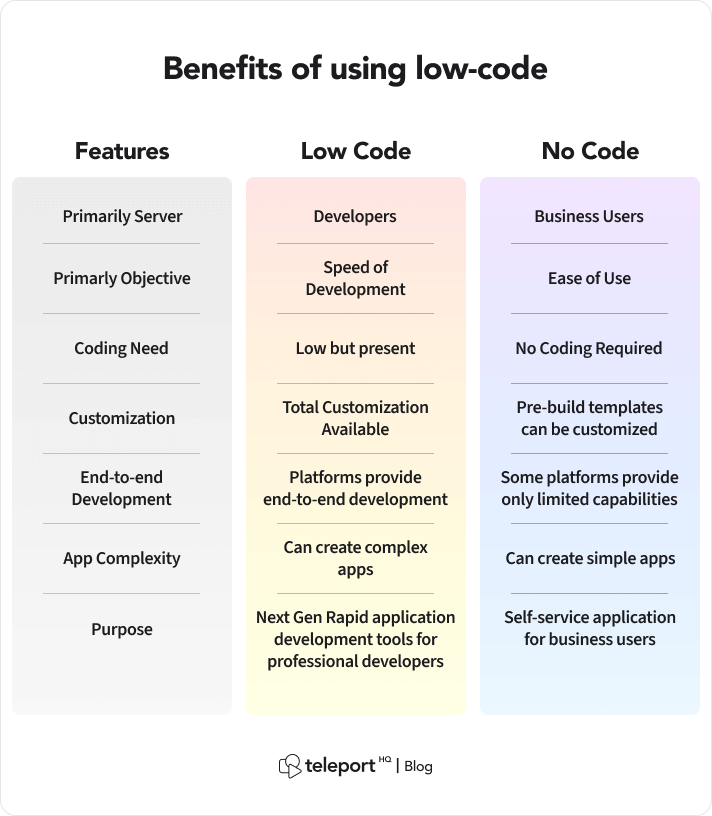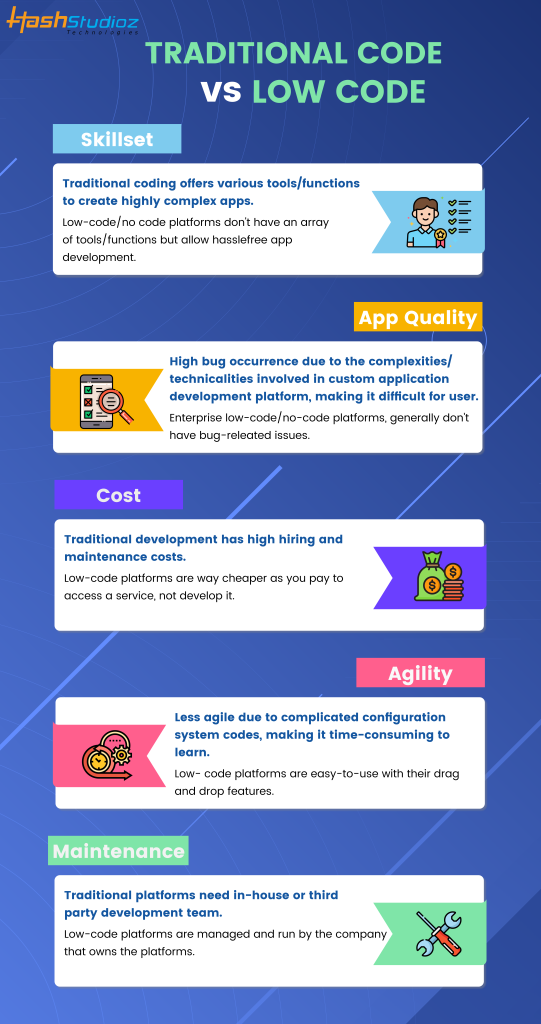New Info For Choosing Low-Code Platform Recommendations
New Info For Choosing Low-Code Platform Recommendations
Blog Article
In Terms Of Integration Capabilities, Low-Code Development Of Applications Has Numerous Advantages.
Low-code applications offer significant advantages in the area of integration capabilities. These are essential for creating applications that are able to seamlessly connect to various systems and services. Here are some of the key advantages: Prebuilt Connectors and APIs
A Wide Range of Connectors: Low-code platforms generally come with a huge collection of pre-built connectors for the most popular enterprise software (e.g. ERP, CRM, databases, as well as cloud-based services). Integration of the systems can be made easier.
API Integration: Many low-code platforms include integrated APIs that are built-in that allow developers to easily connect with external data sources and services.
User-Friendliness
Drag-and Drop Integration: Many integration tasks are accomplished using drag-and drop interfaces. This lets developers and nondevelopers to create complicated integrations with minimal or no programming.
Visual Workflow Builders Visual Workflow Builders utilized to design workflows, data flows and integrations. They assist in understanding and setting up workflows more efficiently.
Standardized Integration Methods:
SOAP/RESTful Services Support: Standard web service protocols, such as SOAP/REST allow for the easy integration of a variety of external applications and systems.
OData and other Standards Standardization such as OData allows for the easy access and manipulation of data across different platforms and applications.
Real-Time Data Synchronization:
Real-Time Integrations: Lowcode platforms can manage data synchronization in real time between applications and system making sure that data is updated and uniform throughout an organization.
Event-Driven Architecture: Some platforms have support for event-driven architectures, which allow applications to react to events in real-time, which is essential for dynamic and interactive applications.
Legacy System Integration:
Connecting old Systems and New Systems Low-code platforms often provide tools to integrate with existing older systems. This allows companies to upgrade their IT Infrastructure without having to overhaul the current systems.
Data Migration: Built-in tools help transfer data from old applications to the latest ones developed on platforms with low-code.
Third-Party Integration of Services:
Cloud Services: Seamless Integration with Cloud Services such as AWS Azure Google Cloud and Google Cloud allows for easy deployment of applications.
Business Applications Integration: Low-code platforms are able to integrate with various business software like Salesforce, SAP, Microsoft Dynamics, etc. to create a seamless workflow that spans different business processes.
Simplified Data Processing:
Unified data models: Some platforms that offer low-code support for unified data models to facilitate data management across different systems.
Data Connectors: Pre-configured data connectors allow easy access to and manipulation of data from different sources.
Security and Compliance
Secure Integrations Low-Code platforms are designed to make sure that integrations adhere to security protocols and standards. This helps protect data both in transit and when it is being stored.
Compliance Features - These platforms include features to ensure the integrations are compliant to regulatory requirements.
Extensibility:
Low-code platforms permit the use of custom scripts and programs to meet more complex integration needs. This flexibility is available without compromising user-friendliness.
Plug-in Ecosystems: A plug-in ecosystem can be utilized to enhance the integration capability, and allow users to expand the functionality in the event of need.
All in all low-code development platforms provide powerful integration capabilities that make them an excellent tool for building functional and interconnected applications. They facilitate the process of connecting disparate system, improve data flow, and permit businesses to adopt innovative technologies while also leveraging existing ones. Check out the recommended Low-code Platform for application development for blog examples including app development platform, cross platform app development, app platforms, push alerts, cross platform mobile dev, build with docker, azure sql databases, cross platform mobile dev, cross platform mobile development, cross platform mobile development and more.
Benefits Of Low-Code Applications In Governance And Safety
Low-code app development provides several benefits for security and governance. It is crucial to ensure that applications conform to regulations, are secure and well-managed throughout their lifetime. Here are the key benefits: Centralized Governance:
Unified Management Console: Low-code platforms have a central administration console to allow administrators to control and supervise all applications. This ensures consistent governance throughout the organization.
Role-Based Access Control RBAC : These platforms typically include access controls based on roles, which allow administrators define and enforce rules. This permits only authorized users to alter or access specific parts of a program.
Compliance and Regulatory Adherence
Built-In Compliance Features: Many low-code applications are designed to comply with the industry standards as well as regulations (e.g. GDPR, HIPAA). They offer frameworks and tools to ensure that applications comply with specifications.
Audit Trails: Many companies integrate comprehensive logging and audit trail systems, which enable the organization to monitor changes, track access and ensure compliance with both internal and external laws.
Additional Security Measures
Data Encryption. Low code platforms usually provide encrypted data built-in, both in transit and during rest. This safeguards sensitive data.
Security Certifications - A lot of lowcode companies have security certificates, like ISO 27001 (or SOC2) that demonstrate their adherence of high security standards. Users can be assured that the service adheres to these standards.
Automatic security updates for security:
Regular security updates and patches : Low-code platform handle automatic security updates, patches and upgrades. Applications are therefore secured from threats of the present without developer intervention manually.
Security Monitoring Tools: These tools send alerts in real-time and information about security issues that could be causing problems.
Data Governance:
Data Access Policy: These platforms allow companies define and enforce rules for access to data, while making sure that only authorized individuals can access data and it is used properly.
Data Masking, Anonymization and Anonymization Tools: These tools help protect sensitive personal information and are particularly helpful for testing environments.
Consistent application lifecycle management:
Pipelines for deployment and development Low code platforms have integrated pipelines for development and deployment that contain security inspections. These ensure that security is maintained through the entire life cycle of an application.
Version Control: Integrated version control enables the management of changes. It also ensures that all changes to the software are recorded, and if required, reversed. This helps maintain the security of the program.
Authorization, User Authentication and Authorization
Single Sign-On (SSO). Support for advanced authentication and single sign-on makes it easier and enhances security.
Multi-Factor Authentication – Many platforms are equipped with integrated functionality to verify multi-factor identities, providing an additional layer of security.
Policy Enforcement and Compliance:
Policy Templates: Platforms that are low-code typically have pre-defined templates for policies which help companies swiftly implement governance and security policies.
Compliance Monitoring Tools: These give continuous monitoring and a report on the status of compliance. This helps to spot potential problems and address them proactively.
Integration with Existing Security Infrastructure
Seamless Integration: Low-code platforms are designed to integrate seamlessly with existing security infrastructure and tools, including identity management solutions SIEMs (Security Information and Event Management Solutions), and firewalls.
API Security: Built-in API security features ensure that integrations with external systems are secure, securing information and ensuring the integrity of the application.
Training and best practices:
Guided Best Practices : A lot of platforms offer guidelines and best practices to assist non-developers comply with security standards.
Security Training Some low code service providers provide security resources and training to users in order to help them understand how to create and maintain secure applications.
Low-code development can provide a range of governance and security benefits which ensure that apps are developed and maintained in a timely way, safe and in compliance. These platforms have the tools, frameworks and regulatory compliance that are required to secure sensitive data of customers as well as enforce policies and keep regulatory compliance in check, while also simplifying the management of and oversight over the process of developing applications. Check out the top rated get the facts for Enterprise application development with Low-code Platform for more recommendations including develop web application, sso azure, stored sql procedures, cross platform app dev, azure sql server, azure sql server, azure sql databases, app modernization, rad application development, application development platforms and more.
Vendor Support And Community Are Two Advantages Of Low Code Development For Applications.
Low-code applications development platforms are a great way to get vendor support as well as community involvement. Both of these factors are vital for ensuring an effective implementation and continuous maintenance of the application. Vendor Support
Comprehensive Technical Support:
Support Teams: Many Low-Code platforms provide access an experienced support team that can assist in technical issues, guidance and troubleshooting.
Some vendors offer 24/7 support. This is especially beneficial for multinational companies that have different time zones.
Training and Onboarding
The structured training programs offered by vendors provide structured courses such as webinars or courses for certification. This helps users quickly get to grips with the platform.
Personalized onboarding: Many companies offer customized services for customers who are new, to help them implement the platform properly and to customize it to meet their specific needs.
Regular Updates, Enhancements and Enhancements:
Continuous Improvement: Lowcode platform vendors usually regularly release updates that contain new features, performance improvements, and security patches. This is a way to ensure that the platform is up-to-date and secure.
Feedback Integration: A lot of vendors incorporate user input in their process of development. This ensures that the platform adapts to the evolving needs and wants of its users.
Comprehensive Documentation:
Documentation - In depth Documentation: A complete and well organized documentation covering everything from basic use to advanced modifications and is usually available. This lets users solve problems independently.
API References: API documentation is detailed and helps developers to integrate APIs with other platforms and to further customize their applications.
Professional and Consulting Services
Expert Consultation : Vendors provide consultancy services, including designing architecture and complex implementations. They offer this service to ensure that users can take full advantage of the platform.
Custom Development Service: Some vendors will offer custom development to build functions or integrates for their customers that aren't readily available.
Community Support for the Community
Active User Groups:
Discussion and Forums: Many Low-code platforms feature vibrant online communities, which allow users to ask questions, debate solutions, and collaborate with one another on the best methods.
Virtual and local User Groups: These groups give you the chance to connect, share knowledge and share knowledge.
Knowledge Sharing and Collaboration
Community-Contributed Resources: Users often share templates, modules, and extensions that they have developed, which can be reused or adapted by others, accelerating development and innovation.
Crowdsourced problem solving The collective knowledge and experience of the crowd is an excellent resource when it comes to tackling issues and coming up with inventive solutions.
Development and learning:
Community-Led Learning: Several communities host workshops, training sessions, and webinars, which are usually led by users with experience who are able to provide insight and more advanced methods.
Online Tutorials and Courses: Members of the community frequently share and create online tutorials, classes, and guides for how to perform tasks that enhance learning resources.
Feedback and Influence
Forums for Product Feedback Community forums contain a number of channels for giving feedback to vendors, which will help in the development of features.
Beta Testing Programmes Participants in the Community who are active may be able to participate in beta programs. This gives them an early glimpse of the latest features, as well as an opportunity to contribute to the evolution of the platform.
Recognition and encouragement:
Many vendors have communities recognition programs like MVP programs (Most Valuable Professional) that recognize the contribution of those who are active in their respective communities.
Peer Support: Community members give support to each other, sharing their experience and offering guidance. They create a collaborative and supportive atmosphere through sharing their expertise.
In the end, the combination of robust support from the vendor with a vibrant and active community provides an extensive support ecosystem to develop low-code applications. The combination of strong vendor support and a vibrant, engaged community provides an extensive support system for low-code development.